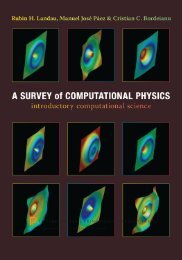Statistical Physics
Statistical Physics
Statistical Physics
- No tags were found...
Create successful ePaper yourself
Turn your PDF publications into a flip-book with our unique Google optimized e-Paper software.
2EntropyIn the previous chapter, we introduced the principle of equal probability. Inthis chapter we define entropy on the basis of this principle. Temperature isdefined through this entropy. We develop a general theory here; in particular,we discuss the condition for thermal equilibrium under the constraint ofa given total energy. It is shown that this is the condition that the entropy ismaximized.2.1 The Microcanonical DistributionWe consider a system enclosed by an adiabatic wall. By an adiabatic wallwe mean that energy cannot be transferred through this wall. The systemcan be a gas, liquid, or solid. For this system, the volume V ,thenumberofmolecules N, and the total energy E are kept constant. These variables representthe only possible constraints for this system. Other than these constraints,we cannot place any restriction on the microscopic motions of the molecules.Therefore, according to the principle of equal probability, each molecule cando anything that is possible under these macroscopic constraints, and variousmicroscopic states should be realized with equal probability in thermal equilibrium.Among these microscopic states, some states may be quite special,such that they will not be realized in reality. However, except for a few suchexceptional states, almost all microscopic states will actually be realized as thestate of the system changes temporally. Because of the vast number of possiblemicroscopic states, the exceptional states will practically never be realizedanyway; this is the conclusion of the previous chapter. We call this situation,where every possible microscopic state is realized with equal probability, themicrocanonical distribution.We write the total number of microscopic states allowed under the macroscopicconstraints as W (E,δE,V,N). Therefore, the probability of each microscopicstate being realized is 1/W .HerewehaveallowedsomeuncertaintyδE in the total energy, and have counted microscopic states where the total











![Práctica [PDF] - Universidad de Carabobo, FACYT - computacion](https://img.yumpu.com/48491415/1/190x245/practica-pdf-universidad-de-carabobo-facyt-computacion.jpg?quality=85)




